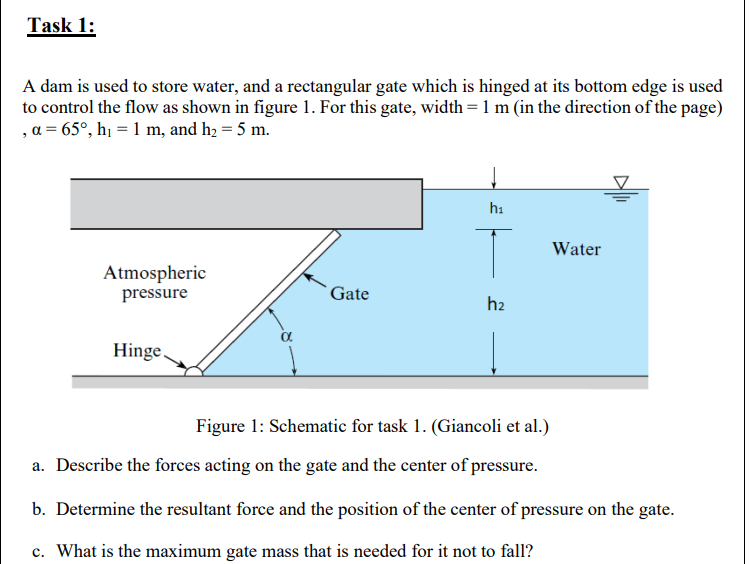A dam is used to store water, and a rectangular gate which is hinged at its bottom edge is used to control the flow as shown in figure 1. For this gate, width = 1 m (in the direction of the page) , α = 65°, h1 = 1 m, and h2 = 5 m. a. Describe the forces acting on the gate and the center of pressure. b. Determine the resultant force and the position of the center of pressure on the gate. c. What is the maximum gate mass that is needed for it not to fall
A dam is used to store water, and a rectangular gate which is hinged at its bottom edge is used to control the flow as shown in figure 1. For this gate, width = 1 m (in the direction of the page) , α = 65°, h1 = 1 m, and h2 = 5 m. a. Describe the forces acting on the gate and the center of pressure. b. Determine the resultant force and the position of the center of pressure on the gate. c. What is the maximum gate mass that is needed for it not to fall
Elements Of Electromagnetics
7th Edition
ISBN:9780190698614
Author:Sadiku, Matthew N. O.
Publisher:Sadiku, Matthew N. O.
ChapterMA: Math Assessment
Section: Chapter Questions
Problem 1.1MA
Related questions
Topic Video
Question
Task 1:
A dam is used to store water, and a rectangular gate which is hinged at its bottom edge is used
to control the flow as shown in figure 1. For this gate, width = 1 m (in the direction of the page)
, α = 65°, h1 = 1 m, and h2 = 5 m.
a. Describe the forces acting on the gate and the center of pressure.
b. Determine the resultant force and the position of the center of pressure on the gate.
c. What is the maximum gate mass that is needed for it not to fall?
d. Show yc, yR, hc, hR, FR, and W on the free body diagram.

Transcribed Image Text:Task 1:
A dam is used to store water, and a rectangular gate which is hinged at its bottom edge is used
to control the flow as shown in figure 1. For this gate, width = 1 m (in the direction of the page)
, a = 65°, hị = 1 m, and h2 = 5 m.
hi
Water
Atmospheric
pressure
Gate
h2
Hinge,
Figure 1: Schematic for task 1. (Giancoli et al.)
a. Describe the forces acting on the gate and the center of pressure.
b. Determine the resultant force and the position of the center of pressure on the gate.
c. What is the maximum gate mass that is needed for it not to fall?
Expert Solution
This question has been solved!
Explore an expertly crafted, step-by-step solution for a thorough understanding of key concepts.
Step by step
Solved in 3 steps with 2 images

Knowledge Booster
Learn more about
Need a deep-dive on the concept behind this application? Look no further. Learn more about this topic, mechanical-engineering and related others by exploring similar questions and additional content below.Recommended textbooks for you

Elements Of Electromagnetics
Mechanical Engineering
ISBN:
9780190698614
Author:
Sadiku, Matthew N. O.
Publisher:
Oxford University Press

Mechanics of Materials (10th Edition)
Mechanical Engineering
ISBN:
9780134319650
Author:
Russell C. Hibbeler
Publisher:
PEARSON

Thermodynamics: An Engineering Approach
Mechanical Engineering
ISBN:
9781259822674
Author:
Yunus A. Cengel Dr., Michael A. Boles
Publisher:
McGraw-Hill Education

Elements Of Electromagnetics
Mechanical Engineering
ISBN:
9780190698614
Author:
Sadiku, Matthew N. O.
Publisher:
Oxford University Press

Mechanics of Materials (10th Edition)
Mechanical Engineering
ISBN:
9780134319650
Author:
Russell C. Hibbeler
Publisher:
PEARSON

Thermodynamics: An Engineering Approach
Mechanical Engineering
ISBN:
9781259822674
Author:
Yunus A. Cengel Dr., Michael A. Boles
Publisher:
McGraw-Hill Education

Control Systems Engineering
Mechanical Engineering
ISBN:
9781118170519
Author:
Norman S. Nise
Publisher:
WILEY

Mechanics of Materials (MindTap Course List)
Mechanical Engineering
ISBN:
9781337093347
Author:
Barry J. Goodno, James M. Gere
Publisher:
Cengage Learning

Engineering Mechanics: Statics
Mechanical Engineering
ISBN:
9781118807330
Author:
James L. Meriam, L. G. Kraige, J. N. Bolton
Publisher:
WILEY